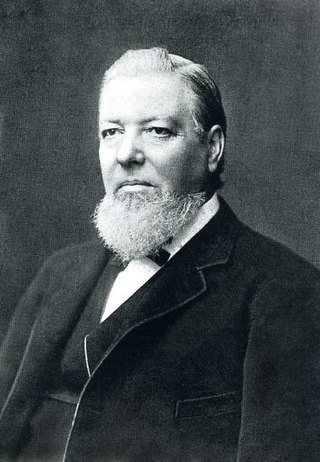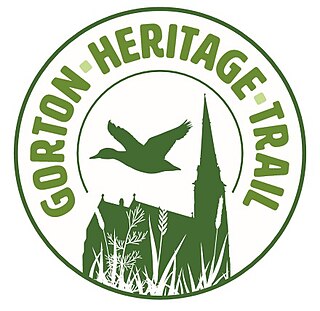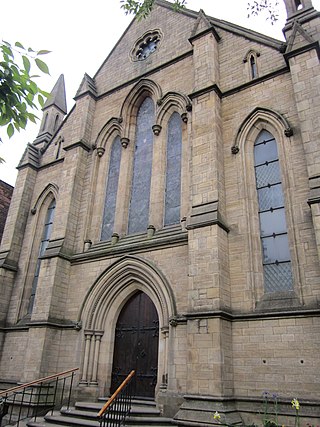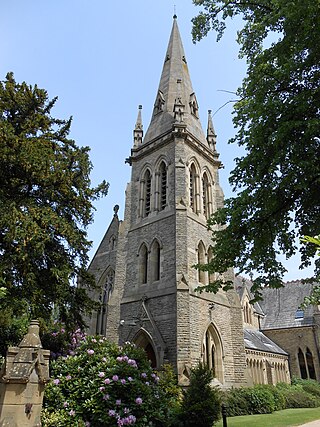
Brookfield Unitarian Church, Gorton, Manchester, England is a Victorian Gothic church. It is a member of the General Assembly of Unitarian and Free Christian Churches, the umbrella body for British Unitarians.

Brookfield Unitarian Church, Gorton, Manchester, England is a Victorian Gothic church. It is a member of the General Assembly of Unitarian and Free Christian Churches, the umbrella body for British Unitarians.
Brookfield Unitarian Church was built between 1869 and 1871 to replace the Gorton Chapel, which stood on the same ground. It was commissioned by Richard Peacock (1820–1889), engineer and Liberal MP for Manchester, and designed by the prolific Manchester architect Thomas Worthington. [1] The church cost Peacock £12,000. It was designated a Grade II* listed building on 3 October 1974. [2] The churchyard lodges and the Sunday School are also listed buildings. The church steeple contains a peal of eight bells, all named after members of the Peacock family.
Nikolaus Pevsner's The Buildings of England describes the church as "very large and strikingly-prosperous looking. Stone, Early English style, with a north-west steeple. The church has a bold, simple, and perfect Ecclesiological interior." [1] The church, and its graveyard, have suffered much from vandalism in recent years.
Peacock, a partner in the locomotive engineering firm of Beyer, Peacock & Company is buried in the cemetery of the church, along with members of his family, in the Peacock Mausoleum, also by Thomas Worthington.
The Church was built on top of the Gorton Chapel, which was established in 1703. There is a stone memorial to the ministers of the Chapel in the church. A notable member of the church was Samuel Birch. [3] [4] The Old Chapel graveyard remains.
The General Assembly of Unitarian and Free Christian Churches is the umbrella organisation for Unitarian, Free Christians, and other liberal religious congregations in the United Kingdom and Ireland. It was formed in 1928, with denominational roots going back to the Great Ejection of 1662. Its headquarters is Essex Hall in central London, on the site of the first avowedly Unitarian chapel in England, set up in 1774.

Gorton is an area of Manchester in Greater Manchester, North West England. It is to the southeast of Manchester city centre. The population at the 2011 census was 36,055. Neighbouring areas include Levenshulme and Openshaw.

Thomas Worthington was a 19th-century English architect, particularly associated with public buildings in and around Manchester. Worthington's preferred style was the Gothic Revival.

Richard Peacock was an English engineer, one of the founders of locomotive manufacturer Beyer, Peacock and Company.

The Church and Friary of St Francis, known locally as Gorton Monastery, is a Grade II* listed former Franciscan friary in Gorton, Manchester, England. It was designed by the noted Victorian architect Edward Welby Pugin and built 1866–1872. Gorton Monastery is a noted example of Gothic Revival architecture.

Chowbent Chapel is an active Unitarian place of worship in Atherton, Greater Manchester, England. It was built in 1721 and is the oldest place of worship in the town. It is a member of the General Assembly of Unitarian and Free Christian Churches, the umbrella organisation for British Unitarians. The chapel was granted Grade II* Listed status in 1966.

Christ Church is a church in Walshaw, Greater Manchester, England, and is a Grade II* listed building. Designed in the Gothic Revival style by Lawrence Booth in 1888, the building was funded by Rev John Gorrell Haworth and Miss Nancy Haworth, and took four years to complete. It was erected as a memorial to Manchester cotton and fustian manufacturer Jesse Haworth, as noted prominently across the west facade of the building.

The Memorial Hall in Albert Square, Manchester, England, was constructed in 1863–1866 by Thomas Worthington. It was built to commemorate the bicentennial anniversary of the 1662 Act of Uniformity. One of the best examples of Venetian Gothic revival in the city, the hall is a Grade II* listed building.

Holy Trinity Platt Church, is in Platt Fields Park in Rusholme, Manchester, England. It is an active Anglican parish church in the deanery of Hulme, the archdeaconry of Manchester, and the diocese of Manchester. The church is recorded in the National Heritage List for England as a designated Grade II* listed building. It is the second "pot church" designed by Edmund Sharpe, so-called because the main building material used in the construction of the church is terracotta.

Gorton Heritage Trail is located approximately 3 miles from the centre of Manchester, England. The trail has been designed to promote and conserve the heritage and wildlife of Gore Brook Valley. It lies mainly within the Gore Brook Conservation area. There are eight listed buildings and other places of interest along the trail.

The Church of St Peter and St Paul is in the market town of Ormskirk, Lancashire, England. Dating from no later than the 12th century, it is one of only three churches in England to have both a tower and spire, and the only one to have them both at the same end of the church. It is an active Anglican parish church in the Diocese of Liverpool. The church is recorded in the National Heritage List for England as a designated Grade II* listed building.

Ellen Wilkinson High School was housed, until it closed in 2000, in a Grade II* listed building in Ardwick, Manchester, England, designed in 1879–80 by the prolific Manchester architect Thomas Worthington. Formerly known as Nicholls Hospital, the building was funded by Benjamin Nicholls as a memorial to his son, John Ashton Nicholls. Nicholls commissioned Worthington to prepare designs in 1867, with instructions that building was only to commence after his own death. It was Worthington's last significant commission in the city. The original usage was as an orphanage; the Ashton family gave over £100,000 to its construction and endowment.

The City Police Courts, commonly called Minshull Street Crown Court, is a complex of court buildings on Minshull Street in Manchester. The court was designated a Grade II* listed building on 3 October 1974.

The Peacock Mausoleum is a Victorian Gothic memorial to Richard Peacock (1820–1889), engineer and Liberal MP for Manchester, and to his son, Joseph Peacock. It is situated in the cemetery of Brookfield Unitarian Church, Gorton, Manchester. The mausoleum was designed by the prolific Manchester architect Thomas Worthington. It was listed Grade II* on the National Heritage List for England on 3 October 1974.

The Church of St Wilfrid is an Anglican church in the suburb of Northenden in Manchester, England. It stands on Ford Lane, close to the River Mersey, approximately 8 kilometres (5.0 mi) south of Manchester city centre.

Merseyside is a metropolitan county in North West England. It was created by the Local Government Act 1972, and consists of the metropolitan boroughs of Knowsley, St Helens, Sefton, Wirral, and the city of Liverpool. Buildings are listed on the recommendation of English Heritage to the Secretary of State for Culture, Media and Sport, who makes the decision whether or not to list the structure. Grade I listed buildings are defined as being of "exceptional interest, sometimes considered to be internationally important"; only 2.5 per cent of listed buildings are included in this grade. This is a complete list of Grade I listed churches in the metropolitan county of Merseyside as recorded in the National Heritage List for England.

St Joseph's Church is an active Roman Catholic church on Chapel Street in Bedford, Leigh in Greater Manchester, England. It is in the parish of St Edmund Arrowsmith. It has been designated by English Heritage as a Grade II listed building.

Bank Street Unitarian Chapel is a Unitarian place of worship in Bolton, Greater Manchester, England.

St Paul's Methodist Church is a former Methodist church in the Manchester suburb of Didsbury. The building was designed by the architect H.H. Vale as a church for the nearby Wesleyan Theological Institution and opened in 1877. The building was converted into an office space in 1990. It is recorded in the National Heritage List for England as a designated Grade II listed building.
Manchester is a city in Northwest England. The M18 postcode area is to the southeast of the city centre, and contains the area of Gorton. The postcode area contains 14 listed buildings that are recorded in the National Heritage List for England. Of these, three are listed at Grade II*, the middle grade of the three grades, and the others are at Grade II, the lowest grade. The area is now mainly residential, and the listed buildings include houses, churches, a mausoleum, a public house, a war memorial, and a former school.